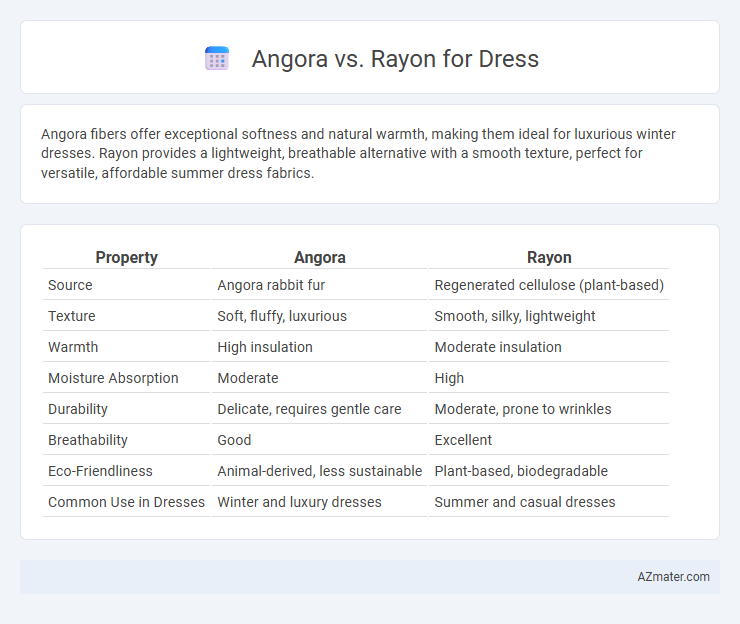Angora fibers offer exceptional softness and natural warmth, making them ideal for luxurious winter dresses. Rayon provides a lightweight, breathable alternative with a smooth texture, perfect for versatile, affordable summer dress fabrics.
Table of Comparison
| Property | Angora | Rayon |
|---|---|---|
| Source | Angora rabbit fur | Regenerated cellulose (plant-based) |
| Texture | Soft, fluffy, luxurious | Smooth, silky, lightweight |
| Warmth | High insulation | Moderate insulation |
| Moisture Absorption | Moderate | High |
| Durability | Delicate, requires gentle care | Moderate, prone to wrinkles |
| Breathability | Good | Excellent |
| Eco-Friendliness | Animal-derived, less sustainable | Plant-based, biodegradable |
| Common Use in Dresses | Winter and luxury dresses | Summer and casual dresses |
Introduction to Angora and Rayon Fabrics
Angora fabric, derived from the soft hair of Angora rabbits, is prized for its lightweight warmth and luxurious texture, often used in high-end dresses for its silky feel and natural insulation. Rayon, a semi-synthetic fiber made from cellulose, offers a breathable and smooth fabric with excellent draping qualities, making it a versatile choice for affordable, stylish dresses. Understanding the distinct sources and properties of Angora and Rayon helps designers select fabrics that balance comfort, appearance, and durability in dressmaking.
Origins and Production Methods
Angora fibers originate from the Angora rabbit, prized for its softness and natural warmth, produced through meticulous combing or shearing techniques that preserve fiber integrity. Rayon, a semi-synthetic fiber, is derived from regenerated cellulose obtained mainly from wood pulp through chemical processes like the viscose method, which transforms natural materials into versatile, smooth fabric. The natural origin of Angora contrasts with Rayon's chemically engineered production, influencing texture, breathability, and sustainability factors in dressmaking.
Texture and Feel Comparison
Angora fabric offers a luxurious, soft, and warm texture derived from Angora rabbit fibers, making it ideal for cozy, high-end dresses. Rayon, a semi-synthetic fiber made from cellulose, has a smoother and cooler feel with excellent drape, providing a lightweight and breathable option for warmer climates. Compared to Angora, Rayon lacks the same plush softness but excels in moisture-wicking and easy maintenance.
Durability and Longevity
Angora fibers, derived from Angora rabbits, offer a soft and luxurious texture but tend to be less durable and prone to pilling over time compared to rayon. Rayon, a semi-synthetic fiber made from cellulose, provides stronger resistance to wear and maintains its shape longer, making it a more durable choice for dresses intended for extended use. The longevity of dresses crafted from rayon generally surpasses that of Angora, especially when subjected to regular washing and daily wear.
Breathability and Comfort
Angora fiber, derived from Angora rabbits, offers exceptional softness and warmth but tends to retain heat, making it less breathable for warm climates. Rayon, a semi-synthetic fabric made from cellulose fibers, provides superior breathability and moisture-wicking properties, ensuring greater comfort in hot and humid conditions. Choosing between Angora and Rayon depends on the desired balance between insulation and airflow, with Rayon favored for lightweight, breathable dresses and Angora ideal for cooler environments.
Care and Maintenance Requirements
Angora requires delicate care, often needing hand washing with mild detergent and air drying to maintain its softness and prevent fiber damage. Rayon is prone to shrinking and losing shape if machine washed; therefore, it should be washed in cold water on a gentle cycle or dry cleaned. Both fabrics benefit from avoiding excessive heat during ironing and should be stored properly to prevent pilling or wrinkles, preserving the dress's quality.
Cost and Affordability
Angora fabric, derived from Angora rabbit fibers, is significantly more expensive due to its labor-intensive harvesting process and luxurious softness, making it a premium choice for high-end dresses. Rayon, a semi-synthetic fiber made from cellulose, offers a more affordable alternative with versatile textures and good drape, ideal for budget-conscious consumers seeking stylish and comfortable dresses. Cost-effectiveness of rayon dresses makes them accessible for mass-market fashion, whereas Angora dresses cater to niche markets with a higher price point and exclusivity.
Environmental Impact and Sustainability
Angora fibers, derived from Angora rabbits, offer biodegradability and renewable sourcing but raise ethical concerns due to animal welfare issues and intensive farming practices. Rayon, a semi-synthetic fiber made from cellulose, often involves chemical-intensive production processes that contribute to water pollution and deforestation, affecting sustainability negatively. Choosing sustainable dress materials requires evaluating the balance between renewable biological origins and the environmental footprint of manufacturing methods.
Best Uses in Dressmaking
Angora and rayon differ significantly in dressmaking applications, with Angora prized for its soft, luxurious texture and exceptional warmth, making it ideal for winter dresses and high-end fashion pieces. Rayon, a versatile semi-synthetic fiber, excels in creating lightweight, breathable dresses with excellent drape, perfect for summer wear and fluid, flowing designs. Choosing Angora enhances insulation and texture in colder seasons, while rayon optimizes comfort and movement in warm-weather or casual attire.
Which Fabric is Right for Your Dress?
Angora, known for its softness and warmth derived from Angora rabbit fibers, offers a luxurious yet delicate fabric ideal for cozy, winter dresses but requires careful maintenance to avoid damage. Rayon, a semi-synthetic fiber made from regenerated cellulose, provides a lightweight, breathable, and versatile option that drapes well, making it suitable for both casual and formal dresses across seasons. Choosing between Angora and Rayon depends on the dress's intended use: Angora excels in warmth and texture for cooler climates, while Rayon delivers comfort and ease of care for year-round wearability.

Infographic: Angora vs Rayon for Dress
 azmater.com
azmater.com